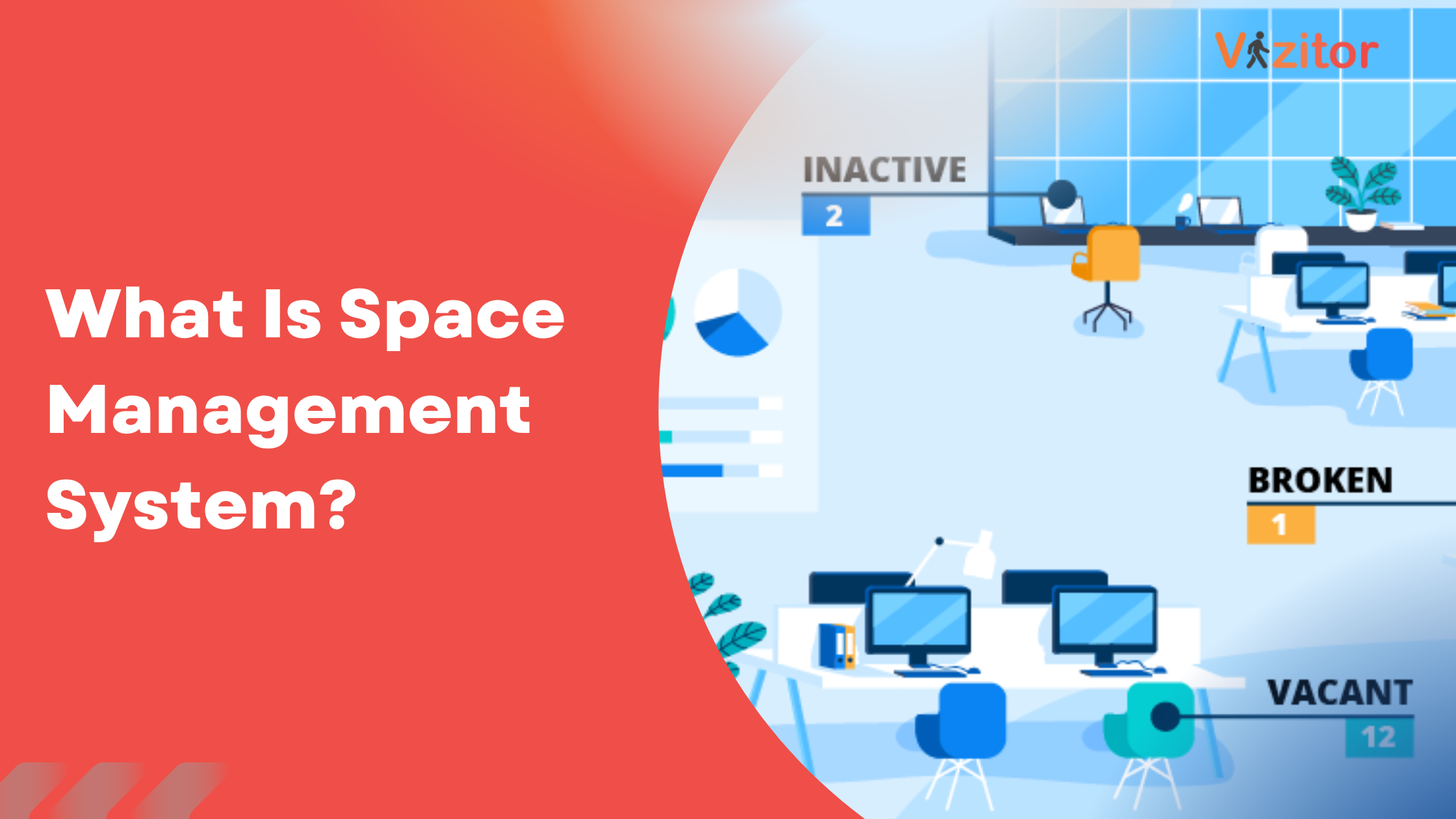Table of Content
Try Vizitor for Free!

Mon, Jun 17, 2024
Read in 11 minutes
According to a recent report by Gartner, 77% of organizations have significantly enhanced their operational efficiency by implementing space management systems. These systems are crucial in modern facility management, streamlining space planning and utilization across various industries.
Space management systems are comprehensive tools that help organizations efficiently manage their physical spaces. These systems encompass various aspects of facility management, including space planning, allocation, and optimization. By leveraging space management tools, companies can ensure that their work environments are used effectively, reducing wasted space and optimizing available resources.
Effective space planning is essential for creating a productive and comfortable work environment. Space management systems enable organizations to design and plan their spaces to meet the needs of their employees and operations. From arranging workstations to allocating meeting rooms, these systems provide the tools for strategic space planning.
A robust space management system can significantly transform how organizations manage their physical spaces. Vizitor’s advanced space management solutions are designed to help companies optimize their facilities, improve space utilization, and drive operational efficiency.
Understanding Space Management
Space management is the process of planning, allocating, and overseeing the physical spaces within an organization. This involves tracking and managing how space is used, optimizing the layout of office areas, and ensuring that resources are allocated efficiently to meet the organization’s needs. Effective space management can lead to significant improvements in productivity, cost savings, and employee satisfaction.
The concept of space management has evolved over time, initially stemming from the broader field of facility management. The origins can be traced back to the early 20th century when companies began to focus on optimizing their office environments to boost productivity. However, it was not until the advent of modern technology and the rise of the digital workplace that space management systems became more sophisticated and widely adopted.
The development and introduction of dedicated space management systems were pioneered by companies in the real estate and property management sectors. Organizations like IBM and other tech giants began to develop software solutions in the 1980s and 1990s to manage their sprawling office spaces more effectively. These early systems focused on basic space allocation and tracking.
Key Features of Space Management Systems
Real-Time Space Monitoring: Modern systems offer real-time tracking of space usage, helping organizations identify underutilized areas and optimize space allocation.
Automated Space Allocation: These systems can automate the process of allocating space based on predefined criteria, ensuring efficient use of available resources.
Detailed Analytics and Reporting: Space management tools provide detailed analytics and reports on space utilization, enabling data-driven decision-making.
Space Planning: Advanced space planning features allow organizations to design and plan their office layouts to maximize productivity and comfort.
Integration with Other Systems: Space management systems can integrate with other facility management tools, HR systems, delivery management and IoT devices to provide a comprehensive view of space usage.
The Future of Space Management
As the workplace continues to evolve, space management systems are expected to become even more sophisticated. Emerging technologies such as AI, machine learning, and advanced sensors will further enhance the capabilities of these systems, allowing for predictive space management and more personalized work environments.
In conclusion, space management systems have revolutionized the way organizations manage their physical spaces. Vizitor’s advanced space management solutions are designed to help companies optimize their facilities, improve space utilization, and drive operational efficiency.
What Are The Benefits Of Space Management?
Implementing a robust space management system offers numerous benefits, from improved space utilization and cost savings to enhanced employee experience and environmental sustainability. Vizitor’s advanced space management solutions are designed to help companies achieve these benefits, driving operational efficiency and creating better work environments.
1. Improved Space Utilization
Optimized Layouts: Space management systems help organizations design and implement optimized layouts, ensuring that every square foot of space is used effectively.
**Reduced Wasted Space:**By identifying underutilized areas, companies can repurpose or eliminate excess space, leading to cost savings.
2. Enhanced Productivity
Better Work Environments: Efficient space management creates comfortable and well-organized work environments, which can boost employee morale and productivity.
Collaboration Spaces: Effective space planning can include the creation of dedicated collaboration areas, fostering teamwork and innovation.
3. Cost Savings
Lower Overhead Costs: By maximizing space utilization and reducing wasted space, companies can lower their real estate and operational costs.
Energy Efficiency: Optimized space usage often leads to reduced energy consumption, contributing to lower utility bills and a smaller environmental footprint.
4. Flexibility and Scalability
Adaptable Workspaces: Space management systems support flexible work arrangements, such as hot-desking and remote work, allowing organizations to adapt to changing workforce needs.
Scalability: As companies grow or downsize, space management systems can help them scale their physical spaces efficiently.
5. Data-Driven Decision Making
Accurate Analytics: These systems provide detailed analytics on space usage, occupancy rates, and trends, enabling data-driven decisions about space planning and resource allocation.
Predictive Insights: Advanced space management tools can offer predictive insights, helping organizations anticipate future space needs and plan accordingly.
6. Enhanced Employee Experience
Comfortable Environments: Well-managed spaces contribute to a more comfortable and pleasant work environment, improving overall employee satisfaction.
Health and Safety: Effective space management can ensure that workplaces are designed to meet health and safety standards, providing a safer environment for employees.
7. Streamlined Operations
Efficient Resource Allocation: Automated space allocation and real-time monitoring streamline operations, reducing the time and effort required to manage physical spaces.
Centralized Management: Space management systems often integrate with other facility management tools, providing a centralized platform for managing all aspects of a workplace.
8. Enhanced Communication & Collaboration
Clear Space Allocation: Transparent space management ensures that employees are aware of available resources and their allocation, reducing confusion and improving communication.
Support for Hybrid Work: By facilitating flexible work arrangements, space management systems support hybrid work models, enabling better collaboration between remote and on-site employees.
9. Environmental Benefits
Sustainable Practices: Optimized space usage can lead to more sustainable practices, such as reduced energy consumption and lower carbon emissions.
Green Building Certifications: Effective space management can help organizations achieve green building certifications, demonstrating their commitment to environmental responsibility.
10. Compliance & Reporting
Regulatory Compliance: Space management systems can help organizations ensure compliance with building codes, health and safety regulations, and other legal requirements.
Accurate Reporting: Detailed reporting capabilities support compliance audits and provide documentation for regulatory purposes.
What Are the Top Factors to Consider When it Comes to Space Management?
Effective space management requires careful consideration of various factors, including space utilization, flexibility, technology integration, employee experience, cost management, health and safety, environmental sustainability, space planning, data analytics, employee engagement, stakeholder collaboration, and continuous improvement. Let’s check out more.
1. Space Utilization and Optimization
Current Utilization Rates: Analyze how existing spaces are being used to identify underutilized areas and opportunities for optimization.
Future Needs: Consider future growth and changes in workforce dynamics to ensure that the space management plan can accommodate evolving needs.
2. Flexibility and Scalability
Adaptable Workspaces: Design spaces that can easily be reconfigured to support different work styles and changing business requirements.
Scalability: Ensure that the space management system can scale with the organization’s growth, allowing for easy expansion or downsizing.
3. Technology Integration
Space Management Software: Utilize advanced space management tools that offer features such as real-time monitoring, automated space allocation, and detailed analytics.
IoT and Sensors: Incorporate IoT devices and sensors to collect data on space usage and environmental conditions, providing actionable insights.
4. Employee Experience
Comfort and Well-being: Create comfortable and ergonomic work environments that enhance employee satisfaction and productivity.
Collaborative Spaces: Design areas that promote collaboration and teamwork, supporting various work activities and interactions.
5. Cost Management
Budget Considerations: Develop a space management plan that aligns with the organization’s budget, balancing cost efficiency with the need for effective space utilization.
Operational Costs: Monitor and manage ongoing operational costs, such as utilities and maintenance, to ensure long-term cost savings.
6. Health and Safety
Regulatory Compliance: Ensure that all spaces comply with health, safety, and building regulations to provide a safe work environment.
Emergency Preparedness: Design spaces with safety features and emergency protocols in mind, ensuring quick and efficient responses to potential hazards.
7. Environmental Sustainability
Energy Efficiency: Implement energy-efficient designs and practices to reduce the environmental impact and operational costs.
Sustainable Materials: Use sustainable and eco-friendly materials in space design and construction to support green building initiatives.
8. Space Planning and Allocation
Needs Assessment: Conduct a thorough needs assessment to determine the specific space requirements of different departments and functions.
Strategic Allocation: Allocate spaces strategically to ensure optimal utilization and support organizational goals.
9. Data and Analytics
Utilization Metrics: Track key metrics such as occupancy rates, space utilization, and density to make informed decisions.
Predictive Analytics: Use predictive analytics to anticipate future space needs and plan accordingly.
10. Employee Engagement
Feedback Mechanisms: Implement feedback mechanisms to gather input from employees about their space needs and preferences.
Change Management: Develop a change management strategy to support employees during transitions and ensure the smooth adoption of new space management practices.
11. Collaboration with Stakeholders
Cross-Functional Teams: Involve cross-functional teams in the space management process, including HR, IT, and facility management, to ensure a holistic approach.
Stakeholder Buy-In: Engage key stakeholders and secure their buy-in to ensure successful implementation and ongoing support.
12. Continuous Improvement
Regular Audits: Conduct regular audits of space usage and management practices to identify areas for improvement.
Feedback Loop: Establish a continuous feedback loop to incorporate employee suggestions and make necessary adjustments to the space management strategy.
The Best Space Management Tools
When considering space management tools, it’s essential to focus on various categories such as space planning software, space utilization sensors, room reservation systems, asset management software, and occupancy sensors. Here’s a breakdown of the best tools in each category without mentioning specific product names:
Space Planning Software
1. Comprehensive Features:
Integrated Solutions: Look for software that offers a wide range of features, including space planning, asset management, maintenance management, and real estate management.
Real-time Data: Ensure the tool provides real-time data and interactive floor plans, making it easy to visualize space usage and plan for future needs.
User-Friendly Interface: Choose software with a user-friendly interface and detailed utilization reports for efficient space management.
2. Advanced Analytics:
Data-Driven Insights: Opt for software that provides robust reporting and analytics capabilities, offering detailed insights into space utilization.
Predictive Analytics: Some tools offer predictive analytics to help anticipate future space needs and support strategic planning.
3. Accuracy and Privacy:
Real-Time Occupancy Data: Utilize sensors that provide real-time data on space utilization and occupancy, ensuring accurate measurements.
Privacy-Friendly: Consider sensors that are privacy-friendly, such as those that do not use cameras but still offer precise occupancy data.
4. Integration Capabilities:
Seamless Integration: Choose sensors that integrate easily with other space management tools and facility management systems.
Detailed Insights: Look for sensors that provide detailed insights into space usage, helping to identify underutilized areas and optimize space efficiency.
Room Reservation Systems
1. Flexibility and Ease of Use:
Workspace Scheduling: Implement systems that offer comprehensive workspace scheduling solutions, including desk booking, meeting room booking, and visitor management.
Real-Time Availability: Ensure the system provides real-time availability and utilization data, supporting flexible work models and efficient space usage.
2. Integration and User Experience:
Calendar Integration: Opt for systems that integrate seamlessly with calendar systems for easy scheduling and management.
User-Friendly Interface: Choose reservation systems with intuitive designs and powerful analytics to enhance user experience and decision-making.
Asset Management Software
1. Tracking and Maintenance:
Asset Tracking: Look for software that offers robust asset tracking capabilities, including check-in/check-out functionality and custom reporting.
Maintenance Management: Ensure the tool provides maintenance scheduling and comprehensive reporting tools to manage assets efficiently.
2. Mobile and Customizable:
Mobile-Friendly: Select asset management software that is mobile-friendly, allowing for easy access and management on the go.
Customization Options: Choose software that offers customization options to meet the specific needs of your organization.
Occupancy Sensors
1. Real-Time Monitoring:
Accurate Data: Use sensors that provide real-time data on space usage and occupancy, ensuring high accuracy and reliability.
Easy Installation: Opt for sensors that are easy to install and integrate with existing space management systems.
2. Environmental Insights:
Comprehensive Data Collection: Consider sensors that not only track occupancy but also monitor indoor climate and environmental conditions.
Energy Efficiency: Look for sensors that provide insights into energy efficiency, helping to optimize resource usage and reduce costs.
Wrapping It Up
Vizitor offers a user-friendly interface and advanced analytics that provide detailed insights into space utilization, helping organizations make data-driven decisions. Its robust space planning solutions ensure that your workspace is always optimized for current and future needs. The integration with space utilization sensors and room reservation systems allows for real-time monitoring and efficient management of office spaces.
Moreover, Vizitor’s asset management capabilities ensure that all resources are tracked and maintained efficiently, reducing operational costs and enhancing overall efficiency. Its occupancy sensors provide accurate data on space usage, ensuring high accuracy and reliability, while also offering insights into environmental conditions and energy efficiency.
In conclusion, Vizitor is the best space management solution available, offering a comprehensive, integrated approach to workspace optimization. By choosing Vizitor, organizations can ensure they are maximizing their space, improving employee satisfaction, and driving overall productivity.









